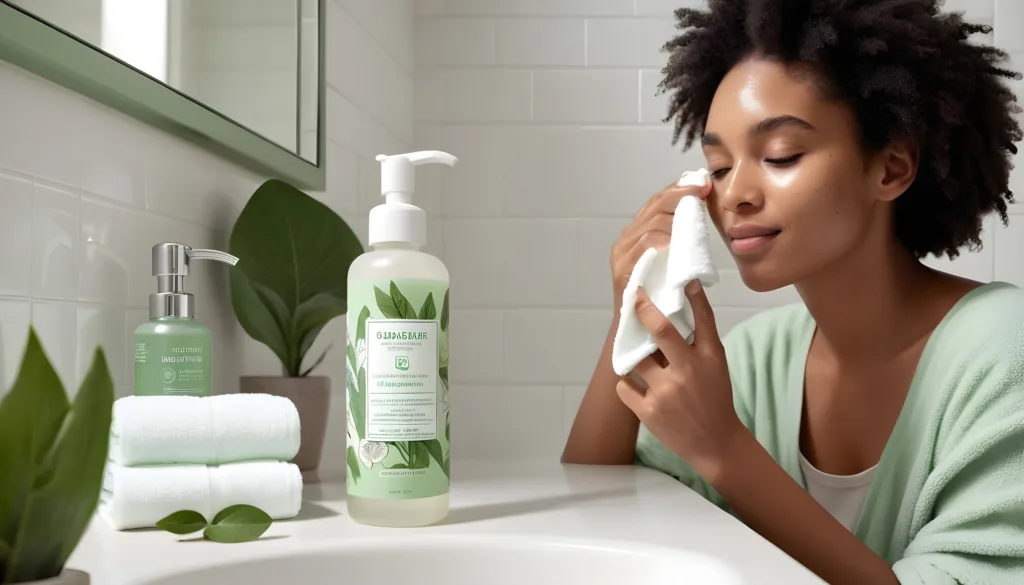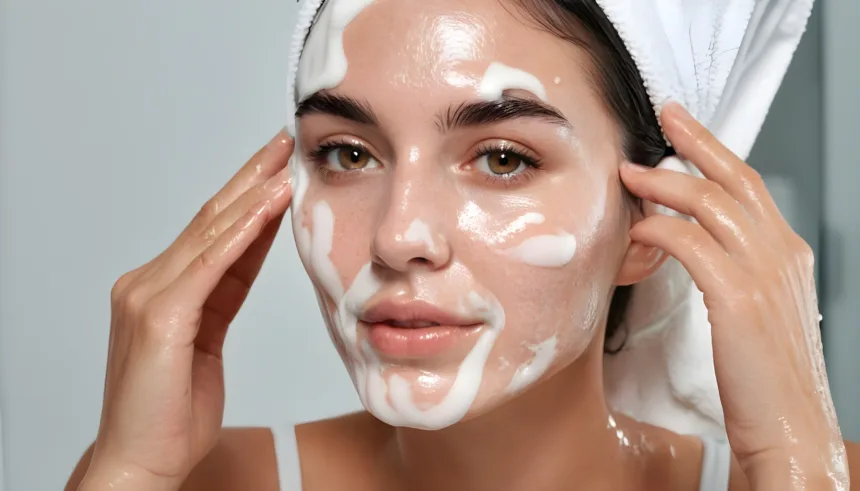It’s a typical morning, and I’m standing in front of my bathroom mirror, staring down at my greatest nemesis—my oily skin. Now, like many others, I’ve heard all sorts of opinions about foaming cleansers and their compatibility with oily skin.
We’ve all been on that quest for the perfect cleanser, the holy grail that cuts through the shine and keeps our complexions matte and under control. And let’s face it, a foaming cleanser seems like the knight in shining armour for oily skin. They lather up beautifully, promising to whisk away excess oil and leave us feeling squeaky clean.
But hold on a sec… are foaming cleansers really all they’re cracked up to be for our oily skin woes? Or could they be secretly wreaking havoc on our delicate complexions? the debate is as sizzling as a hot bubble bath, and we’re about to dive deep to find the answer!
Table of Contents
Understanding Oily Skin: The Nitty Gritty Before the Lather
Before we go all foaming cleanser crazy, let’s take a step back and understand why our skin gets oily in the first place. Think of our skin as a wonderland with tiny oil glands called sebaceous glands. These little guys are supposed to produce sebum, a natural oil that keeps our skin hydrated and protected. But sometimes, these glands go into overdrive, pumping out way more oil than our skin needs.
The culprit behind this oily overdrive can be anything from genetics to hormones (hello, puberty and Aunt Flo!). Stress can also be a major player, making our sebaceous glands go into “defence mode” and produce more oil.
Here’s the thing: Even though oily skin might feel like a curse sometimes, cleansing is still super important! Think of it like this: think of your pores as tiny little craters on your face. Now picture those craters filled with excess oil, dead skin cells, and maybe even some leftover makeup. Not a pretty picture, right? A good cleanser, especially the right kind of cleanser, helps remove all that gunk and keep your pores squeaky clean, preventing breakouts and keeping your skin healthy.
Summer glow-up for oily skin! My article reveals expert tips for controlling shine & keeping your skin healthy all season. Check it out here!
The Foaming Frenzy: What’s the Deal with These Bubbly Cleansers?

Alright, so we’ve established that keeping oily skin clean is key. But what exactly are these foaming cleansers everyone’s talking about?
Imagine a face wash that transforms into a cloud of soft, bubbly goodness when you add water. That, my friends, is the magic of foaming cleansers. These cleansers contain special ingredients called surfactants that attract oil, dirt, and makeup to your skin’s surface. When you add water and lather it up, those surfactants trap the gunk and rinse it all away, leaving you feeling refreshed and (hopefully) shine-free.
Here’s the cool thing: There’s not just one type of foaming cleanser out there. You’ve got:
- Gel cleansers: These lightweight, jelly-like formulas are super popular for oily skin because they lather well and remove excess oil without feeling heavy.
- Creamy foaming cleansers: These guys offer a bit more hydration than gel cleansers, making them a good choice for oily skin that’s also a tad sensitive.
Struggling with oily skin and think oil cleansers are off-limits? Contrary to popular belief, oil cleansers can be a game-changer for oily complexions. Click here to read the full article!
Quick Tip: When choosing a cleanser for your oily skin, keep an eye out for ingredients that are gentle and won’t strip your skin of its natural moisture.
We’ll talk more about those superstar ingredients a little later!
The Big Squeeze: What Makes Foaming Cleansers Tick?
Alright, alright, alright, the suspense is killing me too! Let’s get down to the nitty-gritty and see how these bad boys work their magic on our oily complexions.
Let’s Talk Bubbles: Remember those surfactants I mentioned earlier? They’re like tiny little magnets, drawn to oil and dirt on your skin’s surface. When you add water and work the cleanser into a lather, these surfactants trap all that gunk. Think of it like a bubble bath for your pores – all that nasty oil and dirt gets swept away in a foamy frenzy!
Deep Clean Dream? Unclogging Pores and Removing Excess Oil: Oily skin can be a breeding ground for clogged pores, leading to blackheads and breakouts. Here’s where foaming cleansers can be a lifesaver. Those magic bubbles not only remove surface oil, but they can also penetrate deeper into your pores, flushing out dirt and dead skin cells that can lead to those pesky bumps. The result? Cleaner, clearer, and much less oily skin!
Quick Tip: Don’t go overboard with the lather, though! While a good amount of bubbles can help cleanse your skin, too much friction from rubbing a super-foamy cleanser on your face can actually irritate your skin. Be gentle and focus on massaging the cleanser in circular motions.
Friend or Foe? The Lowdown on Foaming Cleansers for Oily Skin

So we’ve seen how a foaming cleanser can work wonders on oily skin. But are they all sunshine and rainbows? Let’s break it down and see if it’s truly a friend or foe for our oily complexions.
The Good Stuff: Why Oily Skin Might Love the Lather
Oily skin peeps, here’s why foaming cleanser might just be your new BFFs:
- Bye-Bye Shine: Remember that constant battle against the oil slick? it can help control oil production, leaving your skin feeling matte and shine-free for longer.
- Blackhead Blues? Saying No to Clogged Pores: Those pesky blackheads are basically clogged pores filled with oil and dead skin cells. The deep-cleaning power of foaming cleansers can help unclog these pores and prevent future breakouts.
Quick Tip: Look for foaming cleansers that contain salicylic acid, a gentle BHA (beta hydroxy acid) that helps exfoliate and keep pores clear.
The Not-So-Good Stuff: When Foaming Cleanser Goes Rogue
Hold on a sec, before you stock up on every foaming cleanser you see, there’s a flip side to the story. Here’s how these cleansers can go rogue on oily skin:
- Stripping Away Moisture: Some foaming cleansers can be a bit too harsh, stripping your skin of its natural oils and leaving it feeling dry and tight. This can actually backfire, causing your sebaceous glands to go into overdrive and produce even more oil!
- Rebound Oiliness: That squeaky-clean feeling after using a harsh cleanser might be tempting, but it’s not doing your skin any favours. Over-cleansing can disrupt your skin’s natural moisture barrier, leading to – you guessed it – more oil production!
Quick Tip: Avoid cleansers with harsh sulfates (like sodium lauryl sulfate) that can be drying. Look for gentler cleansers with hydrating ingredients like hyaluronic acid or glycerin.
Finding the Perfect Match: Choosing a Foaming Cleanser for Oily Skin

Okay, so a foaming cleanser can be a double-edged sword for oily skin. But fear not! There’s a way to find the perfect one that controls oil without wreaking havoc on your skin.
Look Beyond the Bubbles: Key Ingredients to Seek Out
Let’s ditch the focus on just the bubbles and look for foaming cleansers with ingredients that actually benefit oily skin:
- Moisture Masters: Just because you have oily skin doesn’t mean you don’t need hydration! Look for ingredients like hyaluronic acid or glycerin, which help attract and retain moisture in your skin. This keeps your skin balanced and prevents rebound oiliness.
- Soothing Saviors: Oily skin can also be sensitive. If that’s the case for you, choose ones with calming ingredients like centella asiatica or allantoin to soothe irritation and redness.
Quick Tip: Skip the harsh fragrance and alcohol in some cleansers. These can irritate sensitive skin.
Gentle Giants: Tips for Using Foaming Cleanser Without Stripping Skin
We’ve got the cleanser, now let’s talk technique! Here’s how to use your foaming cleanser like a pro and avoid stripping your skin:
- Lukewarm Water is Your Friend: Super hot water can strip your skin’s natural oils. Stick to lukewarm water to activate the cleanser and rinse it away gently.
- Less is More: Don’t Over-Cleanse: Twice a day is plenty for most oily skin types. Scrubbing your face with tons of cleanser won’t magically remove more oil – it can actually damage your skin. Be gentle and focus on massaging the cleanser in circular motions.
Remember, a happy medium is key! Find a foaming cleanser that removes excess oil without leaving your skin feeling tight and dry.
Ingredient Breakdown: Foaming Cleanser Friends and Foes for Oily Skin

Next up, let’s get down to the nitty-gritty and decode those ingredient lists on your foaming cleansers. Telling your friend from foe is key to finding the perfect match for your oily skin!
The A-Team: Ingredients for Oily and Sensitive Skin
These superstar ingredients are your besties when it comes to foaming cleansers for oily skin:
- Salicylic Acid (Gentle Exfoliation for Acne): This BHA (beta hydroxy acid) is a gentle warrior against acne. It helps unclog pores and keep them clear without being too harsh. Look for the one with salicylic acid, but remember to patch test first!
- Niacinamide (Oil Control and Calming): This magic ingredient helps regulate oil production and keep your skin shine-free. Plus, it has calming properties, which is a win for sensitive skin types.
- Ceramides (Strengthen Skin Barrier): Ceramides are naturally found in your skin and help keep its moisture barrier strong. This prevents dryness and irritation, which can worsen oil production. Foaming cleansers with ceramides are a great choice for oily skin that’s also a tad sensitive.
Quick Tip: When scanning ingredient lists, look for these A-team ingredients higher up on the list. This means there’s a higher concentration of that good stuff in your cleanser.
The B-List: Ingredients to Use with Caution
These ingredients might not be dealbreakers, but they’re worth keeping an eye on, especially if you have sensitive skin:
- Alcohol (Can Be Drying): While alcohol can help a foaming cleanser feel refreshing, it can also be drying. If your skin leans on the sensitive side, skip cleansers with high alcohol content.
- Sodium Lauryl Sulfate (Harsh Sulfate; Look for Gentler Alternatives): This sulfate is a common cleansing agent but, it can also be harsh and stripping. Look for a cleanser with gentler alternatives like sodium coco sulfate or Cocamidopropyl betaine.
- Fragrance (Potential Irritant for Sensitive Skin): Fragrance can irritate some people’s skin. If you have sensitive skin, stick to fragrance-free cleansers.
Remember: Every skin is different, so what works for your bestie might not be your holy grail. Patch-testing new cleansers is always a good idea, especially if you have sensitive skin.
Foaming Cleansers for Sensitive, Acne-Prone Skin: Walking the Tightrope
Ugh, the struggle is real for those of us with oily skin that also freaks out easily! You want to control the oil, but harsh cleansers leave your face feeling like the Sahara desert. So, can foaming cleansers even work for this tricky combo?
Hold on tight, because we’re about to walk a tightrope and find the perfect balance! Here’s how to tame the twin threat of oily and sensitive skin with the help of foaming cleansers:
Taming the Twin Threat: Balancing Oil Control and Sensitivity
- Look for Fragrance-Free Formulas: Fragrance is a common irritant for sensitive skin. Stick to fragrance-free foaming cleansers to avoid any unnecessary redness or stinging.
- Be Wary of Harsh Exfoliants: Those scrubs with big, scratchy granules might be tempting for oily skin, but they’re a big no-no for sensitive skin. They can cause microtears and irritation. Opt for a cleanser with gentle chemical exfoliants like salicylic acid (more on that in a sec).
- Salicylic Acid: A Gentle Warrior Against Acne: Salicylic acid (BHA) is a superstar for oily, acne-prone skin. It helps unclog pores and reduce breakouts without being overly drying. Foaming cleansers with salicylic acid can be a great option, but remember to patch test first to make sure your skin doesn’t react.
Quick Tip: Look for foaming cleansers labelled as “gentle” or “for sensitive skin.” These will often have calming ingredients and be formulated to be less irritating.
The Cleansing Routine: How to Make Your Foaming Cleanser Work for You

So you’ve found your perfect foaming cleanser – high fives! But wait, there’s more to the story than just squirting some cleanser on your face and rinsing. Here’s how to use your cleanser like a pro to get the most out of it:
STEP 1 – Prep Work: Dampen Your Face with Lukewarm Water
Skip the scorching hot water! Extreme heat can strip your skin’s natural oils. Instead, splash your face with lukewarm water to soften the skin and prep it for cleansing.
STEP 2 – Lather Up: Apply a Pea-Sized Amount of Cleanser and Create a Gentle Lather
You don’t need a ton of cleanser to get the job done. A pea-sized amount is plenty! Lather the cleanser up in your hands with a little water. Remember, we’re aiming for soft bubbles, not a mountain of foam.
STEP 3 – Massage Magic: Gently Massage Your Face in Circular Motions, Focusing on Oily Areas (T-Zone)
Be gentle with your skin! Scrubbing harshly won’t remove more oil, it can actually irritate your skin. Instead, use your fingertips to massage the lather in circular motions all over your face. Pay extra attention to oily areas like your forehead, nose, and chin (the T-zone). Spend about 30 seconds cleansing your entire face.
STEP 4 – Rinse and Repeat: Rinse Thoroughly with Lukewarm Water and Pat Your Face Dry (Don’t Rub!)
Once you’ve massaged the cleanser in, rinse your face thoroughly with lukewarm water. Make sure there’s no cleanser residue left behind, which can clog your pores. Finally, pat your face dry with a clean, soft towel. Don’t rub, as this can irritate your skin.
Oily skin cleansed? Don’t skip sunscreen! My article here explains why gel sunscreens are the perfect match for oily skin for a shine-free, protected glow!
Remember: Consistency is key! Using your foaming cleanser twice a day, morning and night, will help keep your oily skin under control.
The Final Lather: Foaming Cleansers – Yay or Nay for Oily Skin?
Okay, we’ve reached the bottom of the sudsy bottle (or should I say tube?) So, is foaming cleanser a yay or nay for oily skin? The answer, like most things in skincare, is… it depends!
Weighing the Pros and Cons: Making the Right Choice for You
The Good Stuff (Yay!)
- Oil Control Champs: They can be excellent at removing excess oil and keeping your shine at bay.
- Deep Clean Dreams: They can help unclog pores and prevent breakouts, which is a major win for oily and acne-prone skin.
- Lather Love (for some): The foamy texture can feel refreshing and cleansing, especially for those who love that squeaky-clean feeling (but remember, squeaky-clean doesn’t always equal good for your skin!).
The Not-So-Good Stuff (Nay!)
- Stripping Power: Harsh foaming cleansers can strip your skin of its natural oils, leading to dryness and irritation. This can actually backfire and cause your skin to produce even more oil!
- Sensitive Skin Blues: Some foaming cleansers can be irritating for sensitive skin.
- Not a Magic Bullet: Foaming cleansers are a great part of your oily skin routine, but they’re not a cure-all. You might need other skincare products to address concerns like breakouts or dehydration.
Quick Tip: Patch test any new cleanser on your inner arm before applying it to your entire face. This helps you check for any potential irritation.
Alternative Cleansers: Exploring Other Options for Oily Skin
Maybe foaming cleansers just aren’t your thing. No worries! There are other cleanser options out there:
- Micellar Water: This gentle cleansing water is a great option for oily skin that’s also sensitive. It removes dirt and oil without stripping your skin.
- Cream Cleansers: These lightweight, non-foaming cleansers can be a good choice for oily skin that’s also dehydrated. They remove excess oil without leaving your skin feeling tight.
The key is to find a cleanser that works for your unique skin. Experiment with different types and see what makes your skin feel happy and balanced! So, are foaming cleansers going to be your new BFF or your oily skin nemesis?
Bonus Round: Q&A on Foaming Cleanser and Oily Skin
Alright, we’ve dissected the world of foaming cleansers for oily skin, but you might still have some lingering questions. No worries, let’s tackle some common ones!
Can foaming cleansers cause breakouts?
It depends! Harsh foaming cleansers that strip your skin of its natural oils can actually backfire and cause your skin to go into oil overdrive, which can lead to breakouts. However, gentle options formulated for oily skin can actually help prevent breakouts by unclogging pores and removing excess oil that can clog them in the first place. The key is to find a cleanser that cleanses without being too stripping.
How often should I cleanse with a foaming cleanser if I have oily skin?
Twice a day is usually enough for most oily skin types. In the morning, a foaming cleanser can help remove any excess oil that builds up overnight. At night, it can wash away makeup, dirt, and oil from the day. However, if your skin feels tight or dry after cleansing, you might be overdoing it. Listen to your skin and scale back to once a day if needed.
Are there any natural foaming cleansers good for oily skin?
You bet! Look for foaming cleansers made with natural ingredients like tea tree oil, green tea, or witch hazel. These ingredients can help control oil and fight breakouts without being harsh on your skin. Just remember to patch-test any new cleanser, even if it’s natural, to make sure it doesn’t irritate your skin.
Remember: Every face is different, so what works for your bestie might not be your holy grail. Experiment with different foaming cleansers and find what keeps your oily skin happy and balanced!



Leave a Reply